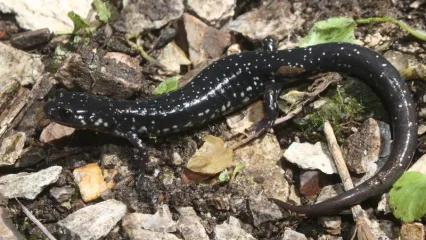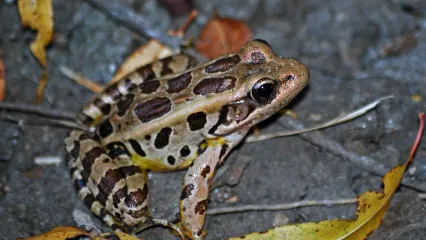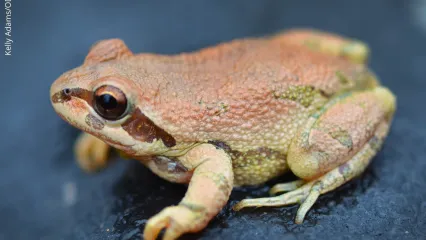
Description
Western slimy salamanders are moderately sized, elongate salamanders with small legs. The tail is about 70 percent as long as the body. The head is slightly wider than the body and the eyes are small. The tail is nearly round in cross section. Western slimy salamanders are black with irregular white spots on the dorsal surfaces of the body, legs, and tail. Along the lower sides of the body, the irregular white markings are larger and often overlap, forming an irregular band of white. The belly is black with occasional small white spots, but the underside of the head is pinkish-red. As their name implies, western slimy salamanders produce a slimy substance from their skin when handled.
Size
Western slimy salamanders can reach nearly 8 inches in total length, but most individuals vary from about 4 to 7 inches.
Habitat
Western slimy salamanders occur on hillsides and in valleys where hardwood forest exists. They are often common in and around limestone outcrops. These salamanders occur in wooded areas of eastern Oklahoma. Their west to east distribution in North America extends from eastern Oklahoma to southwestern Illinois and north to south from southwestern Illinois to southern Arkansas, but with isolated populations in southcentral Texas and eastern Texas. These salamanders are part of a complex of salamanders that are just beginning to be studied. It is highly likely that some of the populations will be determined to be different species.
Life Cycle
During the day, these salamanders seek refuge under rocks, inside rotted logs, and in crevices. At night, they are active on the surface, especially after rainstorms. Western slimy salamanders apparently reach sexual maturity at an age of three to four years, but no studies have confirmed this. Mating occurs in early spring (likely in March). Females use small cavities in burrows, inside of rotted logs, or in crevices for nests where they deposit clutches of ten to 20 eggs during fall (likely in September). Females brood the eggs until they hatch.
Western slimy salamanders feed on a wide variety of arthropods, including ants, beetles, flies, and pill bugs.
Western slimy salamanders have an interesting defense mechanism that is shared with a number of other salamander species. When handled, they produce a thick, sticky substance from glands in their skin. The substance is not only extremely sticky, but is also very difficult to clean. The substance also contains noxious chemicals. In salamanders that have been studied, these substances cause garter snakes to release the salamanders, and as the snakes attempt to rub off the substance, leaves and other debris stick to the mouth of the snake. Meanwhile, the salamander walks away.
How To Observe
Western slimy salamanders are among the easiest of salamanders to observe because they are usually common where they occur. They can be observed by turning rocks or logs, especially in spring during the day or by searching the habitat with headlights at night. Look along the edges of rocks and along longs.
(This profile was created by Dr. Laurie Vitt as part of a partnership between the Wildlife Department and the Sam Noble Oklahoma Museum of Natural History. It was funded as part of a larger State Wildlife Grant to survey and inventory amphibians and reptiles of the Wildlife Management Areas of Oklahoma: T-35-P-1.)

